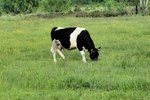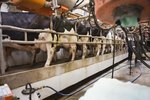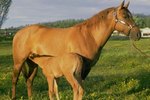
Cows lie down a lot -- it's normal for them to be up and down up to 16 times a day and to spend as much as half their time lying down. In spite of myths and legends about cows, they don't sleep standing, and they don't always lie down when it's going to rain.
When They're Digesting
A cow is a ruminant, meaning she eats first and chews later. She'll graze rapidly, filling the rumen or first chamber of her stomach with grass swallowed whole; then she goes and finds a safe, quiet and comfortable spot, lies down and starts doing the hard work of reducing all that grass to something she can digest. To do this, she does what has been called a "controlled vomit" -- brings small amounts of grass back up to her mouth -- and starts chewing her cud. A cow lying down with her head up, both hind legs to one side and her lower jaw grinding away from side to side is ostensibly a happy and healthy cow.
When They're Tired
When a cow wants to sleep, she does it lying down because she can’t lock her knees the way a horse can to sleep on his feet. A sleeping cow may stretch out flat on her side, but only if she has a partner to keep watch. In a herd, at least one cow will stay up as a sentinel while the others catch 40 winks. A cow gets up in a three-step action, more like a camel than a horse. She rises to her front knees first, then all the way up on her hind legs, and finally she pushes with her hindquarters and lunges forward to get to all four feet. This unfolding process is kind of slow and jerky, and she needs to be able to get up fast if a predator is approaching, so a lone cow is more likely to stay up on her brisket with her rear legs tucked under her and her head curled around to one side, ready for a speedier getaway than from the flat-out position.
When They're Calving
After the nine-month gestation for a cow or a countess, a cow feels some discomfort and, if it's her first pregnancy, a considerable amount of confusion about what's happening. This may lead her to lie down and get up several times during labor. Once birth is imminent, she will usually lie down because it's easier for her to push the calf out in that position. She may even roll back up onto her chest and look around at her hindquarters as if to see why she's so uncomfortable.
When They're Sick or Injured
In cows, up-and-down is good, but down-and-stay is bad news. A cow who lies down and can't get up again is in big trouble -- after she spends about six hours in the same position, bad things begin to happen to her nerves, muscles and joints. Consult a veterinarian immediately to find out why your cow can't get up; the cause may be a pinched nerve from calving, a metabolic imbalance such as calcium or magnesium deficiency, or a broken bone or a systemic disease; or the cow may just be sulking. A "downer cow" that is alert, eating and drinking can be nursed and even lifted with specialized equipment in an attempt to get her back on her feet, but if she isn't up and walking in a few hours, the condition can become terminal.
References
- MilkProduction.com: Cow Comfort: 9) Resting
- Farmers' Almanac: Is It True That Cows Lie Down When It’s About to Rain?
- The Weather Club: Behind the Folklore: Cows Lying Down
- Prairieland Dairy: Facts About Cows
- Manitoba Veterinary Medical Association: Animal MythBusters: Myth: Cow Tipping Is a Popular Prairie Pastime!
- Agricultured: Rumination Is Not Just for Thinking
Resources
- University of Minnesota Extension: Ruminant Anatomy and Physiology
- Bairnsley Highlands: Calving - What to Expect!
- Colorado State University: Calving Management Manual: Abnormal Calving - Pulling the Calf
- The Cattle Site: Down Cows: Potential Problem for Cattle Producers
- Animal Welfare Information Center Bulletin: Handling of Crippled and Nonambulatory Livestock
Photo Credits
-
Brand X Pictures/Brand X Pictures/Getty Images



